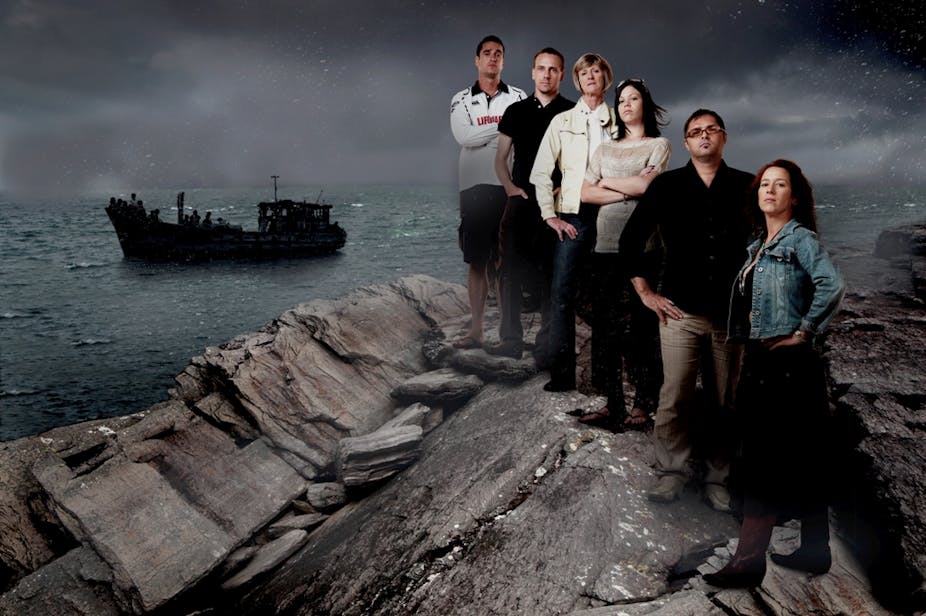Tonight, during World Refugee Week, SBS One premieres Go Back to Where You Came From. Over three nights the series plunges six Australian participants into the intense fear and desperation of the refugee/asylum seeker experience.
They are filmed in situations that force them to confront their attitudes towards refugee and human rights issues.
Their journey takes them to camps in Malaysia, Kenya and Jordan, and to the war zones of the Democratic Republic of Congo and Iraq.
In such a social experiment, using the “Survivor” and “Big Brother” mode of reality television, powerful emotions erupt.
But can expressions of compassion influence “the coldness of the State” with its inhumane refugee policies?
Borderline anxieties
Go Back to Where You Came From airs at a controversial moment in Australia’s ongoing immigration debate.
The Labor government is mired in a major refugee policy crisis with its “Malaysian solution”. It has provoked internal party dissent, public condemnation and a High Court challenge.
The Liberal Opposition takes an uncharacteristic “humane” position and the Greens have voted with the Opposition against the flawed government policy.
Yet the debate is nothing new. Non-Aboriginal Australia has a long and troubled history around refugees, asylum seekers and Indigenous Australians.
Some commentators, such as Aileen Moreton-Robinson and Ghassan Hage suggest that white anxiety around the nation’s borders can be traced back to the original illegal takeover of Aboriginal lands by the British back in 1788.
But there is no Aboriginal presence or perspective in this series.
The form of reality TV
Reality TV is a powerful and emotive form drawn from the documentary tradition of observational film, direct cinema and cinema verite.
It mixes elements of “real life” with constructed situations to produce “performances” for the camera.
Ethnographic filmmaker Jean Rouch suggests the very presence of the camera functions as a psychoanalytic trigger. It changes behaviour to reveal unconscious attitudes.
There are certainly intense moments in this series. Participants face emotional breaking points around their own attitudes, especially in their “heartfelt” interactions with refugee families.
The viewers’ relationship
And some viewers may experience the “borderline” mind of participants and the unstable world of the refugee for themselves.
They could be caught up in the turbulent emotions and crises the various characters in the program experience.
But are these emotions grounded? Or does the reality TV mode itself simply create a performance of “enforced authenticity”?
Does the program go beyond an “unhappy performative”? Individuals might genuinely change their minds as a result of what they’ve experienced, but do the state’s refugee policies change?
It’s worth considering that financial investors in documentaries are often state agencies. And the very same state which creates inhumane immigration policies is funding this program, through the agencies of Screen Australia, SBS and Screen NSW.
A darker side to the Australian character
Certain individuals in the series perform fear, guilt, shame and compassion on Australia’s behalf.
Their vulnerable performances carry “the shadow” for the nation’s shame around refugees and racism.
The camera’s “gaze” is not on the policies of the state, but on its citizens, as represented by the six participants, and their attitudes.
It reforms them, making them better, more “humane”. The program’s on-screen “Big Brother” is the moral conscience of the participants. They need to please him in the successful transformation of their own attitudes and character.
Transformational television or not?
The current immigration debate in Australia is often a wedge issue in politics. It takes place in media cycles of riots, suicides, demonized “boat people”, people smugglers and tragic deaths in leaking boats.
If Go Back to Where You Came From opens up this troubled issue and offers a more humane perspective, then this is perhaps its achievement.
Potent moments occur throughout the series, especially in the Kakuma refugee camp, Kenya, Thursday’s episode. The inflexibility of Australia’s refugee program in not uniting families as a matter of urgency, is given a human dimension.
After years of separation from relatives who sought refuge in Australia, a Congolese family welcomes the program’s participants.
Despite living in intense poverty, they invite the Australians in, desperate for news of their loved ones on the other side of the world.
In the warmth of that human relationship the contrived reality TV format seems momentarily subservient.
Nevertheless the question remains, what of government policy?
In a media-centric environment citizens may evolve on screen, yet the regressive policies of their “cold” state are most likely to remain intact.
Go back to where you came from airs on SBS One at 8.30pm on Tuesday 21st, Wednesday 22nd and Thursday 23rd June.

